Cold allergy is one of many types of negative responses of the body to various external stimuli. The very name of this allergy suggests that an allergic reaction occurs under the influence of cold temperatures.
Until recently, medicine rejected such a diagnosis, since there is no allergen that provokes a specific reaction of the body as such, there is only a physical effect - cold. No allergen means no allergies.
But when exposed to cold air, some sensitive people experience a significant release of histamine, which causes reactions similar to other types of allergies - the development of swelling, vasodilation, redness and itching of the skin and mucous membranes. This is a response to a decrease in the temperature of the skin's thermal receptors.
Causes of cold allergies
Why does cold allergy occur? Medicine does not yet know the exact answer to this question, but with the following factors, particularly sensitive people may experience this strange type of allergy:
- When there is a sharp change in a person’s presence in an environment with normal air temperature to an environment with low temperature - in winter, especially in windy weather
- In contact with cold water - in everyday life when washing dishes, cleaning, swimming in open water
- When drinking very cold drinks or cold food
Allergy to cold often develops after severe illness and long-term treatment with antibiotics; it is believed that it has a genetic predisposition; it can occur against the background of infectious diseases (for example, tuberculosis) or parasitic diseases (roundworms in children, adults, pinworms in children, giardiasis. 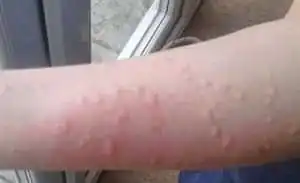
In a strong, hardened organism with a strong immune system, such temperature changes do not cause any reactions.
However, in the event of a decrease in protective forces, systemic disorders, serious illnesses, or metabolic disorders in the body, this type of allergy may occur. Stress, as we know, is the most important risk factor for immune failure, so stress-resistant people tend to get sick less often and have good health.
Provoking factors for the development of cold allergies
- The presence of allergic reactions to other irritants - food, pollen (allergy to poplar fluff), household allergies
- Some infectious diseases - mumps, measles (see symptoms of measles in adults), mycoplasma pneumonia, rubella
- Thyroid diseases, systemic lupus erythematosus, cancer
- The presence of chronic diseases - sinusitis, sinusitis, various worm infections, intestinal dysbiosis
- Recurrent skin diseases – neurodermatitis, eczema, psoriasis
- Hereditary factor
There are cases when such a reaction is hereditary in nature, that is, it is inherited and most often it is the body’s reaction to windy weather than to cold. The symptom of such an allergy is a burning sensation, not itching of the skin.
How does an allergy to cold manifest itself?
How does an allergy to cold manifest itself? Symptoms of such an allergy can have various forms of manifestation - from mild symptoms that disappear some time after contact with a cold environment, to serious recurrent skin rashes.
Skin manifestations are the most common signs. These include redness, swelling, itching of open areas of the body that have come into contact with a cold environment. After some time, the skin begins to hurt, itch, and may become blistered, similar to hives.
Cold allergies in children can even affect the inner surface of the legs, thighs, knees and manifest themselves in the form of hives. The rash is pink, dense, itchy, but goes away within a few hours. There are cases when, after a cold, the skin not only turns red and itches, but also becomes covered with a layer that begins to peel off, as with dermatitis. Sometimes bruises appear at the site of the allergy over time.
Most often, cold allergies occur on the face and hands, since these places are more exposed to the external environment, they are always open and more vulnerable.
General malaise - increased blood pressure, shortness of breath, headache and weakness.
Allergic rhinitis - the appearance of a runny nose, sneezing when going out into cold air. Swelling of the mucous membranes of the nose can either greatly complicate nasal breathing or completely block it, and upon returning to a warm room, all allergy symptoms disappear.
Signs of allergic conjunctivitis are tearing, swelling around the eyes, swelling of the eyelids, pain in the eyes. Hypersensitivity to bright light also occurs. To differentiate the diagnosis, you should definitely consult an ophthalmologist and dermatologist, since if profuse lacrimation occurs in the cold, this may be a sign of tick-borne infection (demodex) or fungus, etc.
Diagnosis of cold allergies
If you experience similar symptoms, then first of all you need to visit a therapist and an immunologist - an allergist. After a set of diagnostic and laboratory tests, it will be possible to accurately determine the cause of the allergic reaction. Cold allergies, the symptoms of which are similar to other types of allergic reactions, should be differentiated from a number of other diseases.
- Sometimes in small children of preschool age, cold allergies on the face are similar to atopic dermatitis, neurodermatitis.
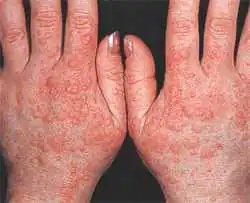
- Often similar allergic symptoms occur with idiopathic dermatosis. With this disease, heat and cold skin receptors are deregulated. Swelling, lacrimation, sneezing, and difficulty breathing occur in both cold and heat.
- Intolerance to the fur of some animals - rabbits, mink, chinchillas, woolen fabrics, sheep's wool - can also be confused with an allergy to cold. When putting on clothes and going out into the cold, a person returns with a rash and swelling of the nasopharynx; as a result, this can be assessed as a reaction to the cold, and not an allergy to wool or fur.
- The situation is similar with perfume products. Typically, perfume is applied to the forearm, neck, face, and an allergic rash can be caused by cosmetics and perfumes, and not by cold.
When symptoms appear, it is important to make a correct diagnosis, and only after differentiating the signs of allergy can a doctor confirm this disease. Then, the question arises: is an allergy to cold treatable?
How to treat allergies to cold
The inability to eliminate an allergen such as cold makes the fight against such an illness quite difficult. If the patient is diagnosed with an allergy to cold, treatment in this case is purely symptomatic. It is only possible with the help of antihistamines to slightly reduce its manifestations, or to protect exposed areas of the body as much as possible from exposure to negative temperatures. You can reduce the occurrence of allergic reactions if:
- Before going out into the cold, lubricate your face and hands with baby cream, for adults, with any rich cream. Lips should be lubricated with hygienic lipstick. This will partially protect uncovered areas of skin from cold air.
- Badger fat has a very good effect; it is rich in unsaturated fatty acids and vitamins B and A, which have only a positive effect on the skin. 20 minutes before going out into the cold, you can lubricate exposed areas of the skin with badger fat (lips, cheeks, nose, hands); if there is no serious liver damage, then you can consume it orally 40 minutes before. before breakfast, 1 tbsp. a spoonful of fat.
- Long warm gloves, preferably waterproof mittens for children, warm scarves, it is preferable to have hoods in outerwear - this will effectively protect from the wind and better retain heat.
- Medicinal herbs, if there is no allergy to them, can also help with the development of urticaria, which appears as an allergy to cold. Burdock root, tricolor violet and walnut leaves are very useful. To collect, mix the raw materials in equal proportions, 2 s. Pour a tablespoon of the mixture into a glass of boiling water, leave for 1 hour, strain, consume the resulting broth 60 ml 3 times a day.
- Pine cones (see pine cones for stroke) or spruce cones also have beneficial properties; 4 cones are required to prepare the decoction; they should be ground in a mill or meat grinder, poured with water and simmered over low heat for half an hour. After straining the broth, you can wipe it on chapped and rough skin every evening.
- If you have a cold allergy, the symptoms of which are minor, then gradual hardening and rubbing can strengthen the immune system and reduce the body's reaction. But for young children and people with intense symptoms, hardening is contraindicated, as it is fraught with the development of complications in the form of anaphylactic shock, Quincke's edema, and laryngeal edema.
- During the cold season, you can use antihistamines (A complete list of all allergy pills is in our article.)
| A drug | Price, rub.) | |
| Antihistamines in tablets | Tavegil | 170-250 |
| Zyrtec | 250-300 | |
| Zodak | 130-200 | |
| Tsetrin | 160-240 | |
| Claritin | 180-240 | |
| Suprastin | 120-140 | |
| Levocetrizine | 170-300 | |
| Cetirizine | 90-100 | |
| Fexofast | 160-200 | |
| Parlazin | 130-140 | |
| Antihistamines creams, ointments (ointments for dermatitis) | Skin cap, Gistan N contains a hormonal substance (list of all hormonal creams and ointments) | 150-160 |
| Gistan, La-kri - contain extracts of medicinal herbs, use it if you are not allergic to them | 170-190 | |
| Auxiliary products for skin irritation | Panthenol spray and cream foam | 200-300 |
| Dexpanthenol cream | 140 | |
| Bepanten | 470 | |
| Antihistamine drops in the nose (For rhinitis from the cold, 20 minutes before going out into the cold) | Allergodil | 280-300 |
| Fenistil | 280-300 | |
| Parlazin | 280-300 |
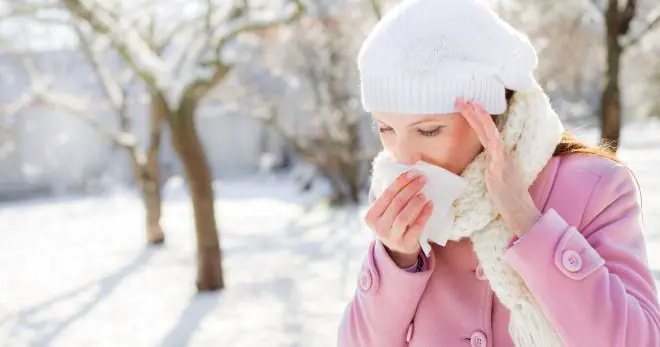
Some people find it difficult to endure the winter period, especially in the presence of strong winds and frost. They exhibit characteristic signs of allergies - rash, conjunctivitis, rhinitis and others. You can cope with such a pathology if you find out and eliminate its original cause.
Is there an allergy to cold?
In this case, negative reactions of the body occur when exposed to low temperatures. A true allergy is an inappropriate response of the immune system and the release of histamines. Such processes occur against the background of contact with chemical rather than physical irritants. For this reason, experts do not consider this disease as an allergy.
The described pathology is not chronic; with correct treatment, all symptoms can be completely eliminated. In medicine, the disease is diagnosed as “cold allergy”, but with the prefix “pseudo”. The basis of therapy is to clarify all the factors that provoke the release of histamines by the immune system when exposed to low temperatures.
Allergy to cold - causes
The occurrence of this problem differs from the mechanisms of development of true immune disorders. There is always an initial pathology that causes a cold allergy; the symptoms and treatment correspond to its causes. The most common factors that provoke the body's reaction to low temperature are:
- long-term use of antibiotics;
- suffering from severe infections;
- helminthic infestations;
- hereditary predisposition;
- deterioration of metabolic processes;
- stress;
- chronic diseases;
- viral lesions;
- intestinal dysbiosis;
- pathologies of the oral cavity (caries, stomatitis, periodontitis);
- immune disorders.
Many people have not only an allergy to frost, but also reactions to contact with other low-temperature environments:
- drinking cold drinks and food;
- washing dishes and floors in non-hot water;
- swimming in open, unheated reservoirs and pools.
Allergy to cold - symptoms
The symptoms of the described disease are similar to a true autoimmune disease. The person suffers from specific symptoms:
- conjunctivitis;
- rhinitis;
- sneezing;
- itching of eyes and nose;
- redness, peeling and swelling of the skin;
- dermatological rashes;
- malaise;
- joint pain;
- increased heart rate;
- dizziness;
- difficulty breathing.
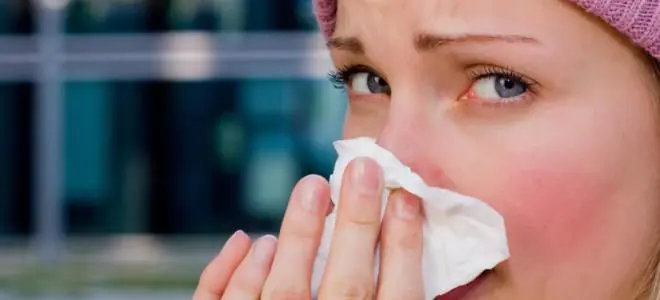
What a cold allergy looks like depends on the following factors:
- general condition of the immune system;
- sensitivity of the epidermis;
- the severity of inadequate reactions of the body;
- duration of contact with the stimulus.
Cold allergy on hands
This symptom of the disease often develops in women, especially after cleaning, washing or washing dishes. Allergy to cold on hands occurs upon contact with water, snow and ice. It manifests itself almost immediately or after a few hours in the form of local and systemic symptoms. Allergy to cold is accompanied by the following clinical picture:
- redness of the skin of the hands;
- rash in the form of hives;
- peeling, cracking of the epidermis;
- swelling of the hands;
- severe itching, pain.
- swelling;
- multiple hematomas, spider veins;
- profuse rashes, blisters;
- severe itching;
- soreness to touch;
- deep cracks, oozing erosion;
- swelling of the nose.
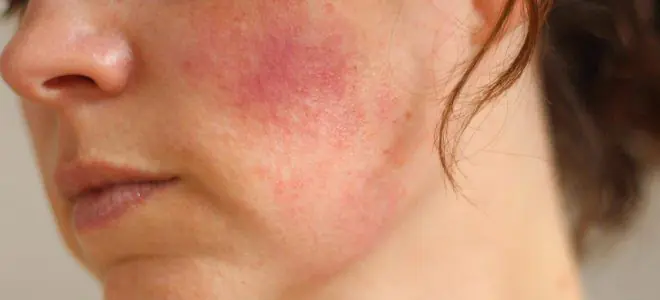
Allergy to cold in the eyes
Often the pathology in question affects the conjunctiva, similar to hay fever. Allergy to frost, cold can be accompanied by swelling and redness of the eyelids, lacrimation. Some people suffer from conjunctivitis, sometimes with putrefactive processes. How does an allergy to cold manifest itself?
- photophobia;
- swelling of the eyelids;
- pain, burning in the eyes;
- pronounced vascular pattern on the proteins;
- sticking of eyelids in the morning;
- feeling of sand in the eyes.
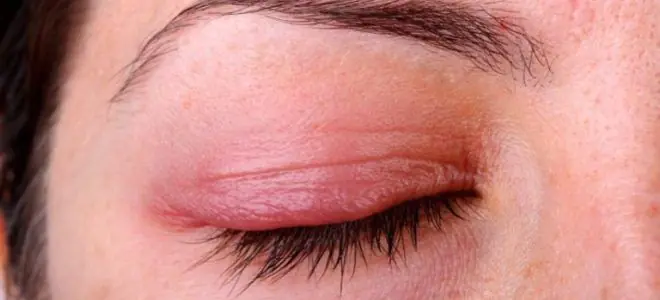
Cold allergy on feet
In winter, even closed areas of the body may show signs of the disease, but such symptoms occur mainly in children. Allergy to cold on the feet has the following manifestations:
- urticaria on the hips, knees, inner surface of the legs;
- skin redness;
- intense itching;
- peeling of the epidermis;
- hematomas;
- the appearance of yellowish crusts on the skin.
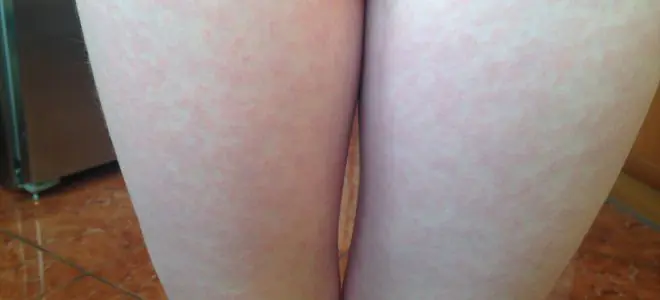
Allergy to cold - what to do?
Therapy for this disease is carried out in 2 directions at once. First, it is necessary to relieve the unpleasant symptoms of the pathology, for which local products are used that soften and heal the skin and relieve inflammation. At the same time, you should find out why the allergy to cold occurred - treating the cause of the disease will help to completely eliminate it. Therapy should be carried out by a qualified specialist.
Cold allergy cream
There are corticosteroid and non-hormonal local remedies that eliminate inflammatory processes and restore the skin. How and how to treat allergies to cold is prescribed by the doctor. Independent use of hormonal, antimicrobial and other potent medications is dangerous and can cause complications. Allergy to cold can be treated with the following creams:
Cold allergy ointment
For severe dryness of the epidermis, peeling and cracking, local preparations with a fatty base are better suited. Treatment of cold allergies is effective using the following ointments:
- We see;
- Fluorocort;
- Dermovate;
- Flucinar;
- Triderm;
- Stellanin;
- Elokom-S;
- Sinaflan and analogues.
Folk remedies for allergies to cold
Alternative medicine offers several effective methods of getting rid of the symptoms of this disease. Before treating cold allergies using traditional methods, it is advisable to conduct tests on the body’s sensitivity to the components of the recipes. Many herbs and foods can also trigger an inappropriate immune system response. Allergy to cold is accompanied by significant damage to the skin, so it is important to simultaneously use products to heal and protect it.
- lemon balm leaves – 20 g;
- valerian roots – 20 g;
- hop cones – 20 g;
- water – 200 ml.
- Mix herbs.
- Pour boiling water over them.
- Leave for 1 hour.
- Strain the solution.
- Drink 1/3 glass before each meal.
Skin lotion
- olive oil – 2-3 tbsp. spoons;
- vitamin E (liquid) – 1 teaspoon;
- vitamin A (liquid) – 2 teaspoons.
- Mix and shake the ingredients well.
- Apply the resulting liquid to exposed areas of the body 3 hours before going outside.
- Blot excess oil mixture with a dry cloth after absorption.



